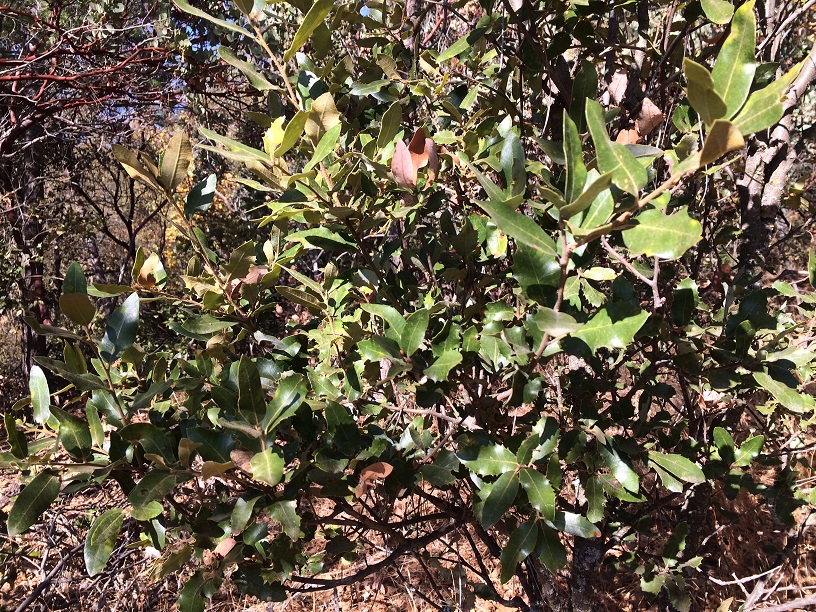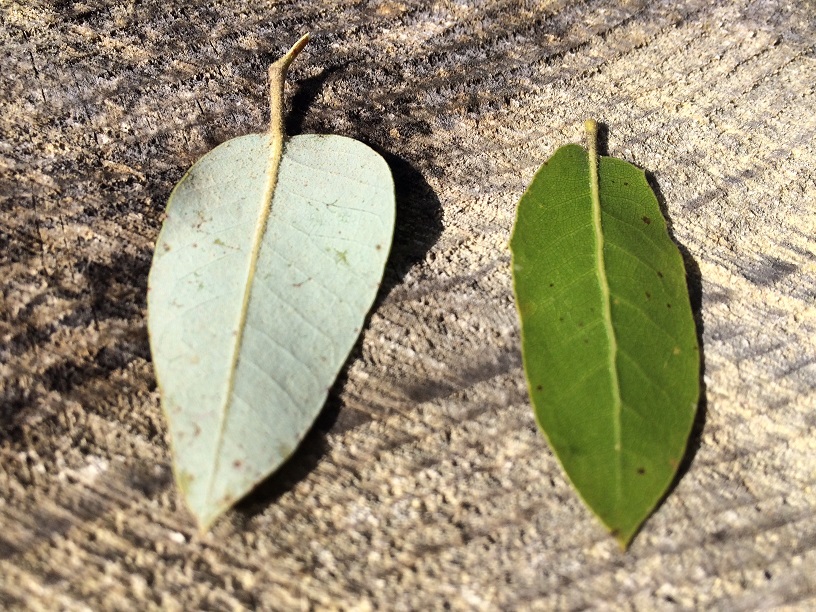

Close-up of Interior Live Oak leaves, autumn. Photo copyright © 2019 Mariposa Native Plants
The Interior Live Oak is found from the Shasta Trinity National Forest south along the California coast, in the foothills and lower mountains of the Sierra Nevada, into the transverse ranges north of Los Angeles, in the Angeles and San Bernardino National Forests, in the San Jacinto Mountains, and in the Cleveland National Forest as to the border with Mexico. It is mostly absent from the Central Valley proper, from the eastern slope of the Sierra Nevada, and from the Mojave Desert. It is one of two live oaks found in Mariposa County, the other being the Canyon Live Oak (Quercus chrysolepis). In the Coast Ranges it is found alongside Coast Live Oak (Quercus agrifolia).
Both the Canyon Live Oak and the Interior Live Oak have leaves that are dark green above, with either finely toothed or smooth edges. However, the bottom of the Q.chrysolepis leaf is rough, yellowish, and leathery, whereas the bottom of a Q.wislizeni leaf is medium green and shiny. The acorns of the two oaks are very different. Q.chrysolepis has a squat, rounded acorn, with a distinctly fuzzy, golden base cap. But Q.wislizeni acorns are long, thin, and bullet-shaped.

Interior Live Oak leaf bottom (left) and Canyon Live Oak (right). Photo copyright © 2019 Mariposa Native Plants
Elevation: sea level to 5,500 ft. (1,600m). The Canyon Live Oak is found at higher elevations, beginning around 3,000 ft. (1000m). Companion plants of the Interior Live Oak are Gray Pines (Pinus sabiniana). and Blue Oaks (Q. douglasii). Sun: partial or full. Temperature: cold tolerant to 10°F (-10°C). Soil: poor, clay, loamy, or sandy; pH 5-7.5.
Oak trees are difficult to transplant, because of their sensitive roots. This tree needs a site that is well-drained and exposed to full or partial sunlight. The roots are sensitive to disturbance; avoid breaking the root ball when planting from the container. The best times to plant them from a container is in the fall or winter, as late as the beginning of February. If the ground is dry, drench the ground around the tree with water after planting, making sure that the top of the root ball is level with ground around the tree. It is helpful to dig the hole down several inches below where the root ball will sit and fill it with loose, original soil, so as to better facilitate penetration by the oak tap root. Planting acorns is more reliable as a method for establishing Interior Live Oak on a landscape. It is also prudent to install a wire screen around the tree, attached to a firmly-planted stake, for the first few years; this prevents browsing by herbivores (especially deer). Water (2 gallons, 8 liters) once per week in the first summer. Water no more than once per month, in the same amounts, in the second summer. Thereafter, no supplemental water should be required. If the third spring before summer is especially dry, then water in the third summer as in the second. Thereafter, no supplemental water should be required. Nota bene: Established California native oak trees should never be watered in the warm spring, summer, and fall months.
Q. wislizenii is a host plant for a number of butterflies and moths.
Interior Live Oak tends to grow with a multi-trunk form. The tilting trunks of the tree are subject to breakage under heavy, wet snow loads. The species name honors the German-American doctor and botanist Friedrich Wislizenus (1810-1889) who collected one of the earliest specimens.
Native Americans relied on Interior Live Oak acorns as a food staple, but only after they leached out the tannins. After roasting, the acorn was used as a coffee substitute by native peoples as well as by settlers.
Seedlings in deep pots (early spring only), in #1 containers (spring and summer), and acorns (12/bag) beginning in late summer.